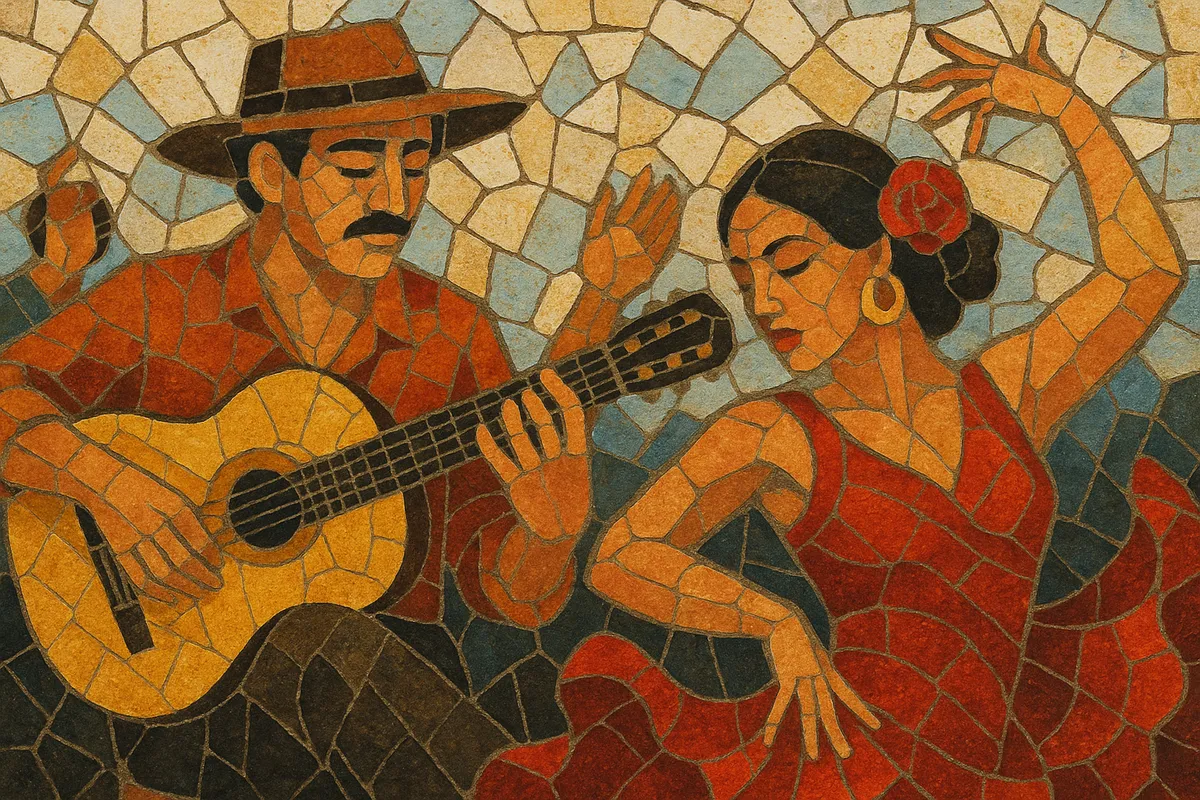Rumba flamenca is a lively, dance-oriented palo of flamenco that blends Afro‑Cuban rumba and son rhythms with Andalusian harmony and flamenco guitar technique.
Characterized by a 4/4 compás with strong syncopation, percussive strumming (rasgueado and abanico), palmas (handclaps), light percussion (often cajón), and call-and-response vocals, it offers a more accessible, festive counterpart to the heavier palos of flamenco.
Harmonically it often relies on the Andalusian cadence (for example Am–G–F–E) or simple I–IV–V progressions, while lyrics tend to be romantic, streetwise, or celebratory, making it a favorite for social dancing and crossover recordings.
Rumba flamenca emerged in Spain in the early 20th century as part of the cantes de ida y vuelta, flamenco forms shaped by musical exchange between Spain and the Caribbean. Returning sailors and migrants brought Afro‑Cuban rhythms (notably Cuban rumba and son) that Andalusian and Gitano musicians adapted to flamenco guitar, palmas, and verse structures.
From the 1940s to the 1960s, rumba flamenca gained visibility in cafés cantantes, tablaos, and studio recordings. Its four-beat, syncopated feel and upbeat mood made it ideal for dance and for blending with bolero and guaracha. The cajón, introduced to flamenco ensembles in the 1970s (popularized by Paco de Lucía), became a natural fit for rumba’s pulse and helped modernize its percussive drive.
In Barcelona’s Gitano communities, rumba flamenca’s patterns mixed with Caribbean and pop influences, catalyzing the creation of rumba catalana in the 1960s. Meanwhile, flamenco innovators and pop-leaning groups in the 1970s–1990s (from Bambino to Los Chichos and Ketama) used rumba grooves to reach mass audiences, seeding nuevo flamenco and flamenco pop.
By the late 20th century, rumba-style flamenco instrumentals and songs became international calling cards for Spanish music. Today, rumba flamenca remains a staple at fiestas and on stage, widely used for crossover projects, acoustic sessions, and modern productions that may incorporate bass, drum kit, or electronic textures while preserving its signature compás and guitar articulation.
Work in 4/4 with a pronounced syncopation. Aim for a groove where beat 1 anchors the bar, the and-of-2 or and-of-3 carries a strum flourish, and beat 4 is reinforced. Typical tempos range from about 95–120 BPM for a relaxed but danceable feel.
Use flamenco-friendly keys (E major, A minor) and the Andalusian cadence (Am–G–F–E) or simple I–IV–V progressions. Melodies are direct and singable, often with short motifs and call-and-response between voice and guitar falsetas.
Employ rasgueados, golpes, and the abanico strum to articulate the pulse and create lift on upbeats. Palm-muted bass notes on strings 5–6 can outline the tumbao-style movement. Add palmas (sordas and claras) to mark accents and a cajón to support the backbeat and syncopations.
Write concise, narrative or romantic verses with catchy refrains. Common formats are verse–chorus with brief instrumental falsetas between sections. Keep verses rhythmically tight so syllables align naturally with the strum pattern.
Start with a locked guitar–palmas–cajón groove. Layer second guitar for counter‑rasgueado or arpeggios. In modern settings, add bass for a subtle tumbao and light percussion (shaker, bongos). Keep mixes open so transient detail of palmas and rasgueado is clear.


